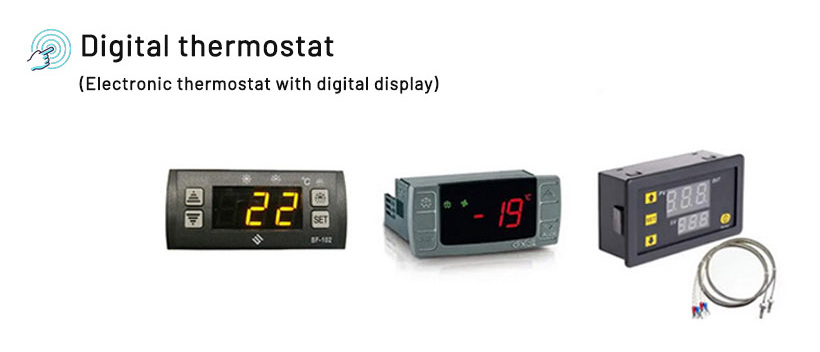4 Types of Thermostats and Their Varieties
Nov 27,2023 - 09:04 Reading:2082
What exactly is a thermostat?
A thermostat denotes a sequence of automatic control mechanisms that physically alter within the switch in response to temperature fluctuations in the surrounding environment. This alteration leads to specific effects, prompting either conduction or disconnection actions. Often referred to as a temperature control switch, temperature protector, or simply a thermostat, it facilitates the control and adjustment of temperature. When the temperature attains the predetermined threshold, it automatically activates or deactivates power to achieve either heating or cooling objectives.
How does a thermostat work?
Generally, the operating principle of a thermostat involves the sampling and monitoring of ambient temperature through a temperature sensor. When the surrounding temperature surpasses or falls below the designated control level, the control circuit initiates and emits the relevant signal to regulate and manage the temperature. Certain thermostats also incorporate an over-limit alarm feature. If the temperature exceeds the set alarm threshold, an auditory or visual signal alerts the user to address the situation promptly.
Applications and Utility of Thermostats
Thermostats boast a wide array of applications and find utility in diverse equipment requiring heating or cooling, such as electric ovens, refrigerators, and air conditioners. Moreover, they are indispensable in various industrial domains like chemical production, pharmaceuticals, and food processing, ensuring precise temperature control during manufacturing processes.
Categorization of Thermostats
When selecting and utilizing a thermostat, considerations such as the controlled object's characteristics, environmental conditions, and precision requirements are crucial. Decisions and adjustments should be based on the specific circumstances. Additionally, during usage, maintenance, and repair, periodic checks for sensor accuracy and sensitivity are necessary to ensure the thermostat's uninterrupted operation.
Thermostats are classified based on functionality, encompassing:
Mechanical Thermostat

Utilizing a mechanical structure for temperature measurement and regulation, it is commonly found in cost-effective household appliances like heaters, air conditioners, and similar systems. It can be integrated into more complex automatic control systems. While cost-effective and straightforward, its drawbacks include limited adjustment range, lower accuracy, and less user-friendly operation.
Electronic Thermostat

Employing electronic components for temperature control, this type stands out for its precision, sensitivity, and versatile functionalities. Mainly utilized in high-end industrial, commercial, and household appliances, it employs diverse adjustment methods such as PID algorithms, pulse width modulation (PWM), zero-point proportional adjustment (ZPH), and fuzzy control, achieving precise temperature control and energy efficiency. Digital thermostats and PID temperature controllers stem from electronic thermostat technologies.
Digital Thermostat

This temperature control device combines a digital display and controller, exhibiting the current and set temperature values and allowing manual settings through buttons or similar methods. It offers high precision, reliability, and user-friendly operation, making it suitable for settings that require frequent temperature adjustments like laboratories or electronic equipment environments.
PID Temperature Controll Thermostat

Widely recognized in process control, the PID controller utilizes proportion (P), integral (I), and differential (D) elements to regulate based on deviations. Leveraging these elements, it calculates control amounts to manage system errors for control. Ideal for scenarios demanding high precision, such as pharmaceuticals or food processing, PID control technology ensures accuracy and stability, especially when exact system parameters are challenging to ascertain or model.
Furthermore, thermostats can be classified based on various use scenarios, detection methods, or appearances. They encompass room temperature types, floor temperature types, and dual-temperature types, each with distinct characteristics and applications. Users can select a suitable type based on specific requirements and intended use cases.
Popular item
-

Mega Top Pizza Prep Table Refrigerator with Pan Rail Top 60″ Inch
(5) -

Cheapest Smallest Fridge Countertop with Glass Door 4 Gallon SC15
(5) -

Cheapest Smallest Cooler Countertop with Glass Door 6 Gallon SC25
(5) -

Cheapest Smallest Refrigerator Countertop with Glass Door 6 Gallon SC35
(5) -

Top Freezer Display Fridge Freezer with Glass Door 55L 1.9 Cu Ft
(5) -

Big Glass Door Kitchen Freezer Side by Side with Auto Defrost 1000 Liters
(5) -

Grocery Store Swing Door Visi Merchandiser with Clear Front
(5) -

Supermarket Horizontal Open Swing Door Merchandiser Refrigerator
(5) -

Vertical Upright Fridge Built in Freezer Fridge 200L 7 Cu Ft
(5) -

Glass Swing Door Cooler Ventilated Cooling 0–10℃ 268 Litre
(5) -

Small Display Merchandiser Cooler with Clear Front 335 Litres
(5) -

Mini Cooler Fridge with Self-Closing Door 105 Litres
(5) -

Small Refrigerator with Slimline Design with Glass Door 135L
(5) -

Small Beverage Cooler with Transparent Door 145 Litres
(5) -

Small Drink Fridge with Glass Door and Led Lights 350L
(5) -

Small Drink Fridge with Glass Door 0–10℃ 310 Liters
(5) -

Stainless Steel Barrel Cooler Mini Bar Fridge for Wine and Beverage
(5) -

Round Pepsi Cooler Freestanding with Top Open Cover
(5) -

Mini Round Topo Chico Cooler Small Barrel Shape Upright
(5) -

Outdoor Mobile Round coke Cooler for Party event Marketing
(5)

































